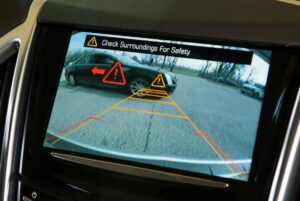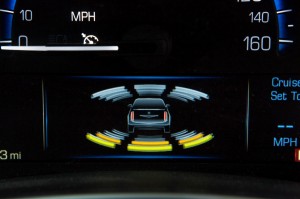 When I saw the phrase “virtual bumper” to describe the new system of cameras and sensors on the ATS, XTS and SRX for the automatic collision avoidance system it really peaked my interest. But, it also made me think what will happen to these system as a vehicle ages.
When I saw the phrase “virtual bumper” to describe the new system of cameras and sensors on the ATS, XTS and SRX for the automatic collision avoidance system it really peaked my interest. But, it also made me think what will happen to these system as a vehicle ages.
The automatic braking system can brake the vehicle without intervention from the driver. It can even augment brake pressures to slow the vehicle in an emergency. The system uses cameras, sensors and a super fast computer to make decision when to apply the brakes. According to GM the systems can improve driver safety and reduce expensive collisions.
In 1971, DOT issued its first passenger car bumper standard that mandated new car to withstand 5 mph impacts without damage to certain safety-related components such as headlamps and fuel systems. In 1972, they went even further by saying it should not cost a lot of money to repair the vehicle after a low speed crash. It made cars like the MGB, Camaro and Jaguar XKE ugly.
But, these bumper systems worked the same if the vehicle had 1,000 or 200,000 miles. The same can not said virtual bumper system if the brake pads, rotors and hardware are not properly maintained.
Imagine that Cadillac when it is 11 years old (current average age of vehicles on the road) with more than 100,000 miles on the odometer. The owner may have had his buddy install a set of cheap brake pads in his driveway without replacing the hardware or refinishing the rotor. He may have not the brake fluid replaced so the isolation and outlet valves in the ABS modulator may stick a little bit. Sure the camera and sonar sensors work, but the brakes are not the same.
It is a simple fact these system will only work as well as how the pads and rotor can stop the vehicle. It is a wake-up call for an industry that offers $99 brake jobs and free brake inspections. Simply put, for the virtual bumper to work it will require the best possible physical brake job.
—————-
 Cadillac’s Automatic Braking System Acts like a “Virtual Bumper”
Cadillac’s Automatic Braking System Acts like a “Virtual Bumper”
Cadillac is the latest brand to offer a system that stops a car without any involvement from the driver.
Cadillac is the latest automotive brand to offer automatic braking, with a system that it claims acts like a “virtual bumper” by stopping cars from hitting obstacles whether they are going forward, or in reverse.
Officially called Front and Rear Automatic Braking, the system does exactly what the name says. Like KITT, vehicles equipped with the system use a variety of sensors, including radar and ultrasonic detectors, to scan for potential obstacles.
If a driver isn’t paying attention to the road or their car’s own warnings (including seat vibrations), a Cadillac can fully apply its own brakes, stopping before it hits anything or reducing impact speed. The driver receives a warning on the head-up display, in they think their car is possessed.
Once the car is stopped, and assuming it wasn’t damaged, the system holds it in place with the parking brake until the driver presses the gas pedal.
Cadillac said its automatic braking system only works under specific circumstances, but it did not say how speed affects operation. Other automatic braking systems, such as Volvo’s City Safety, Mercedes-Benz’s PRE-SAFE, and Subaru’s EyeSight, only work at low speeds, usually under 20 mph.
Read more: http://www.digitaltrends.com/cars/cadillac-automatic-braking/#ixzz27741ylNh